WHAT ARE LEARNING STYLES? Information enters your
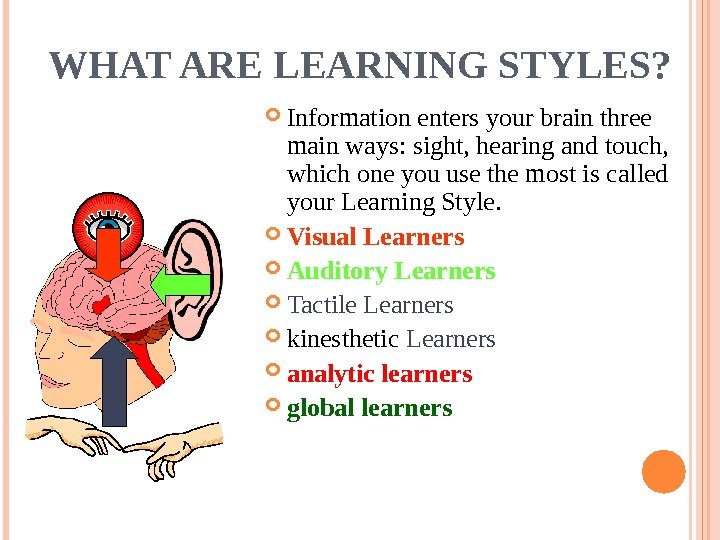
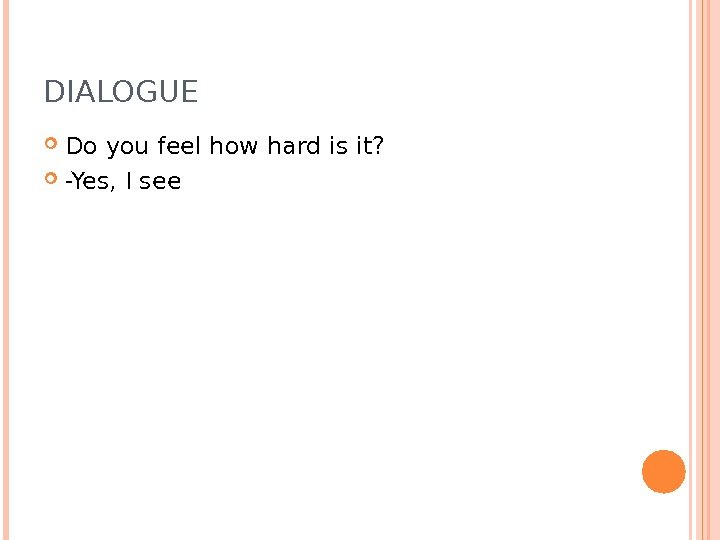
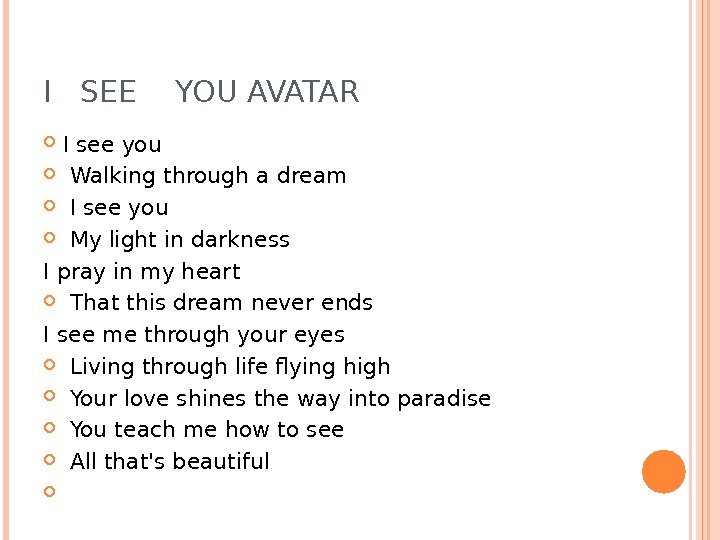
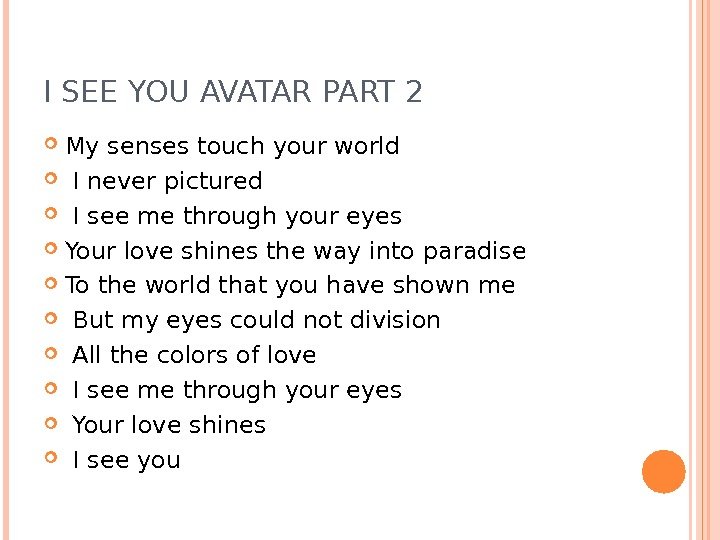
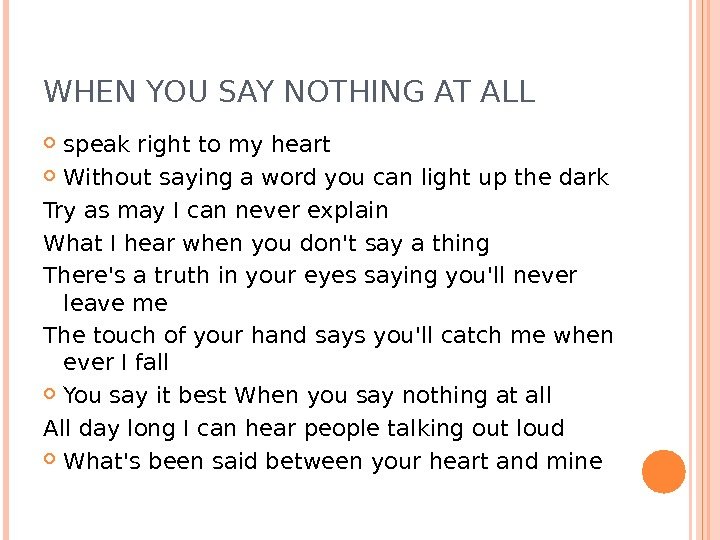
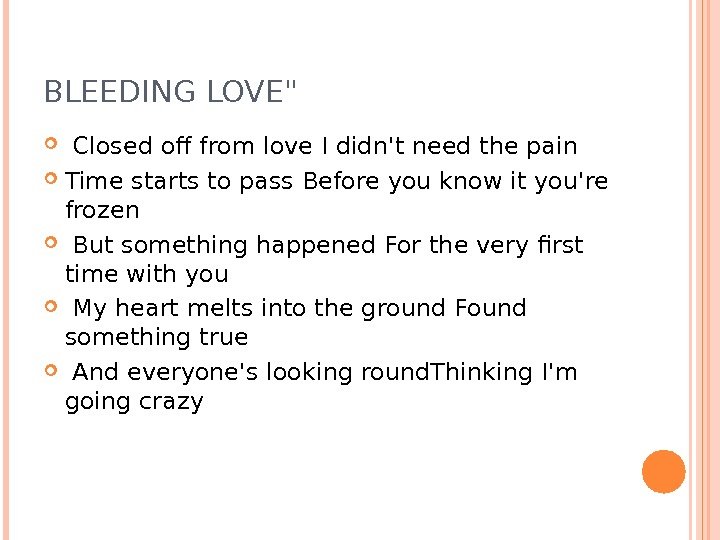
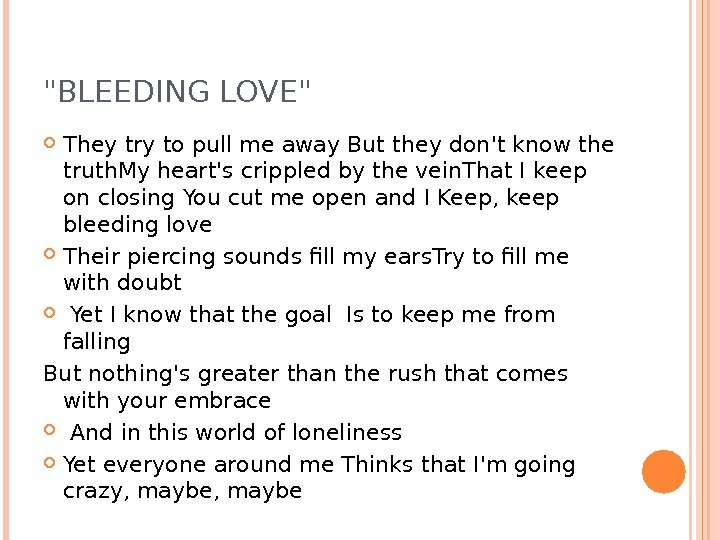

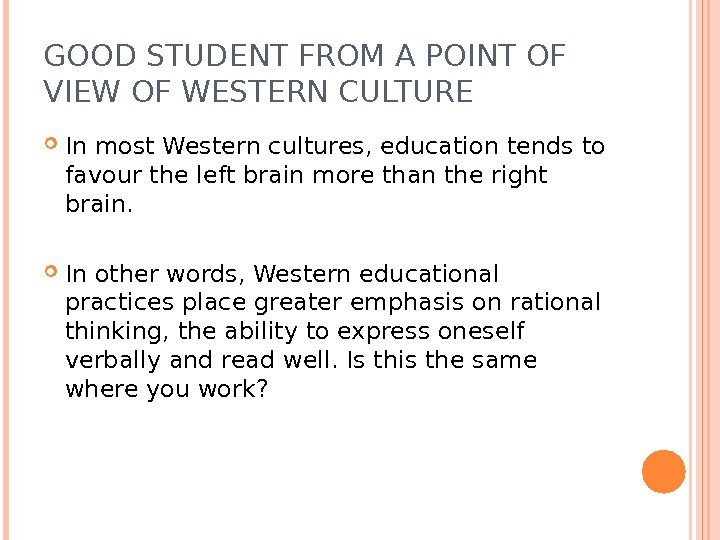
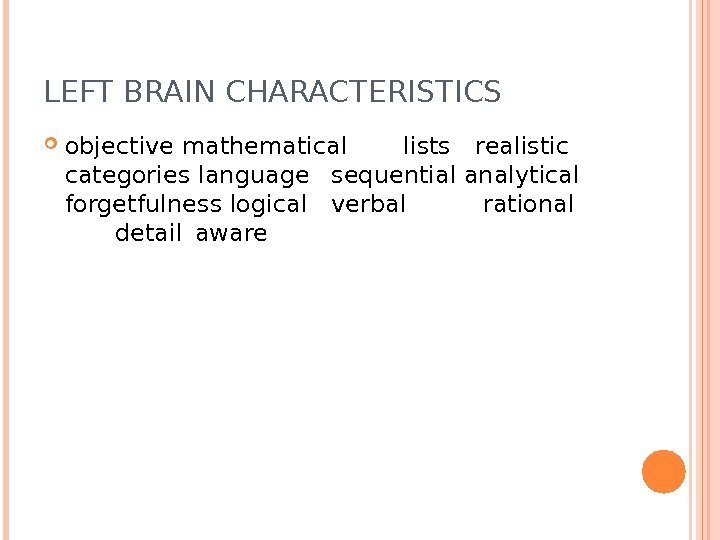
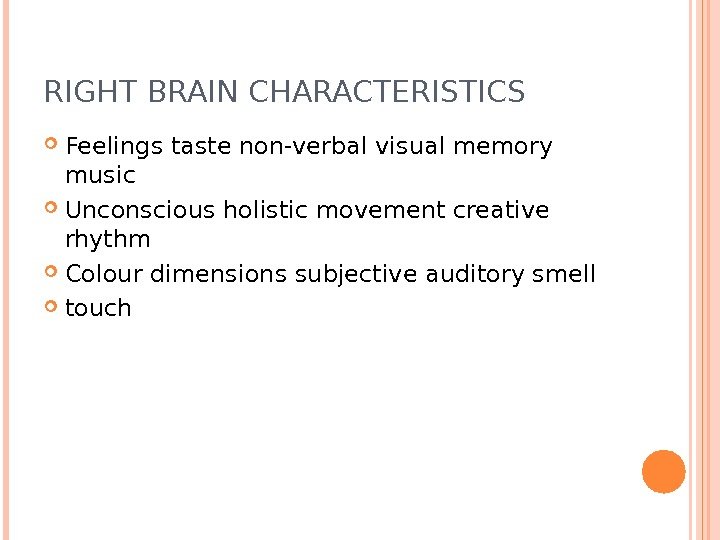
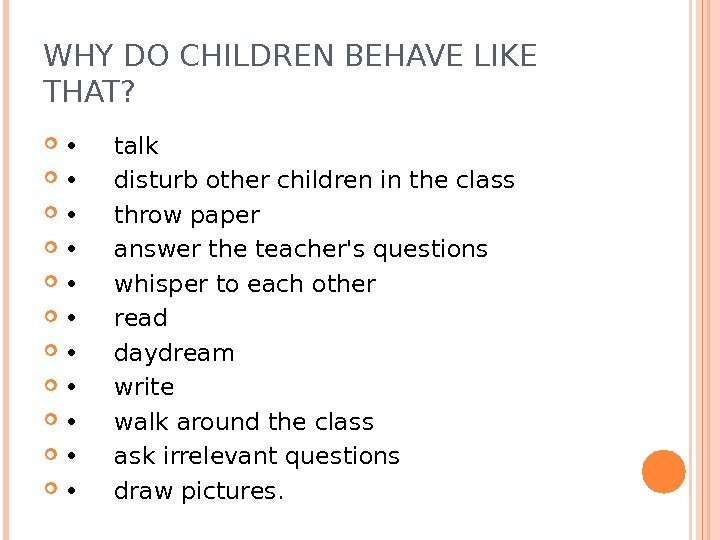
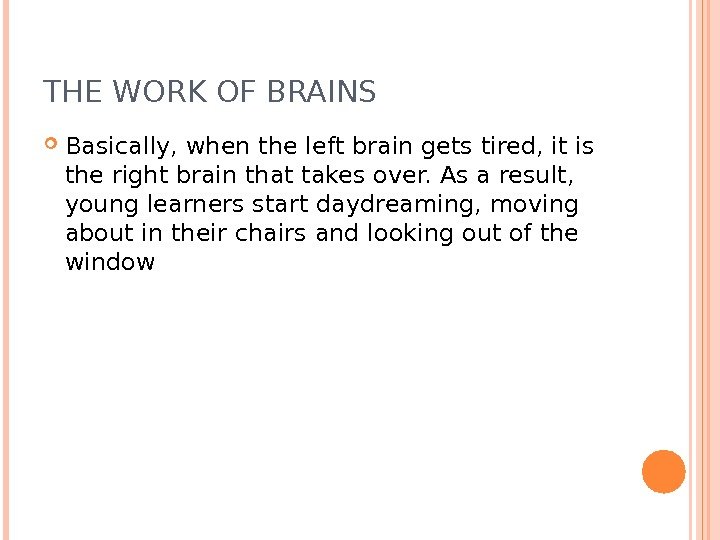
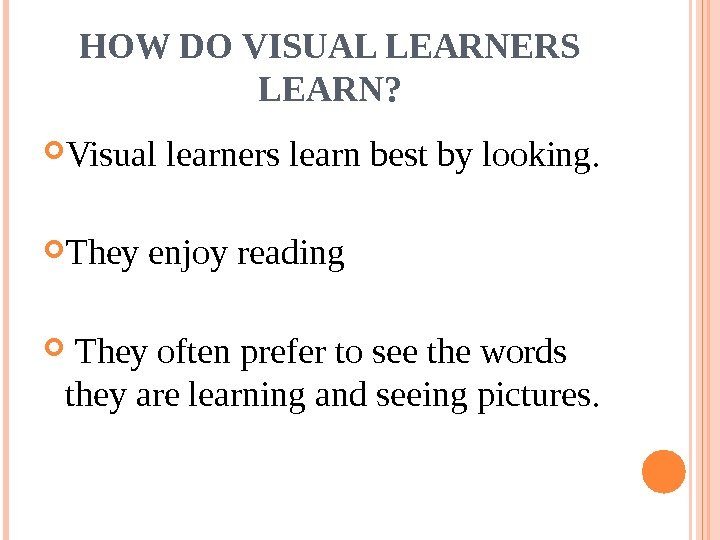
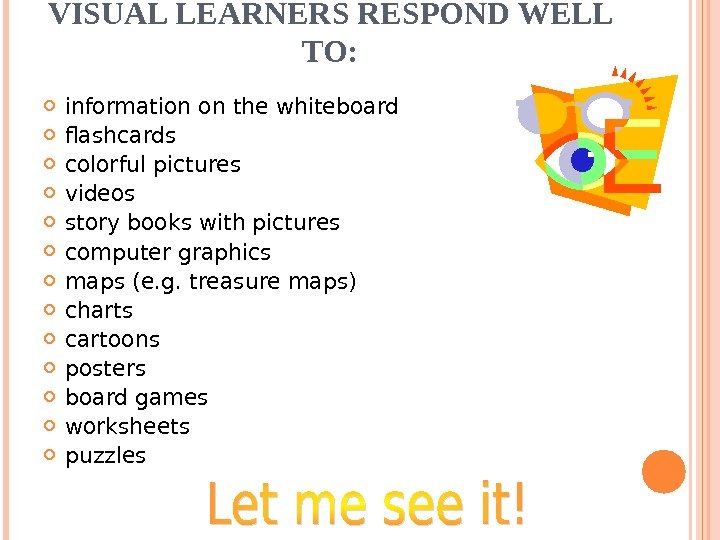
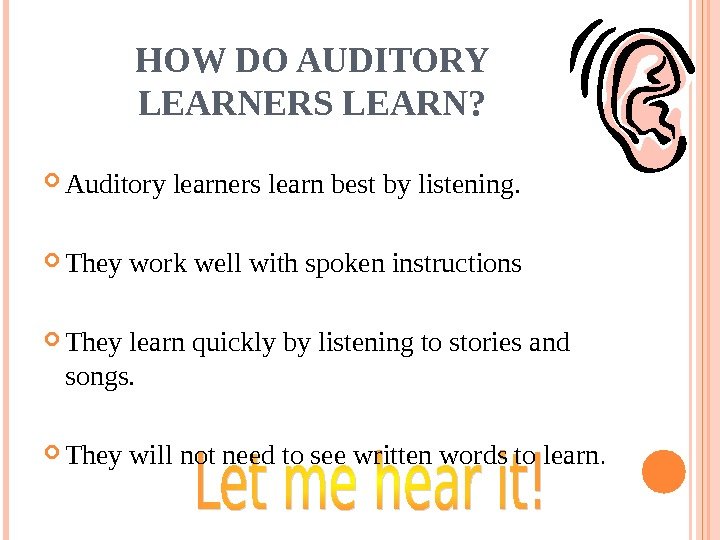
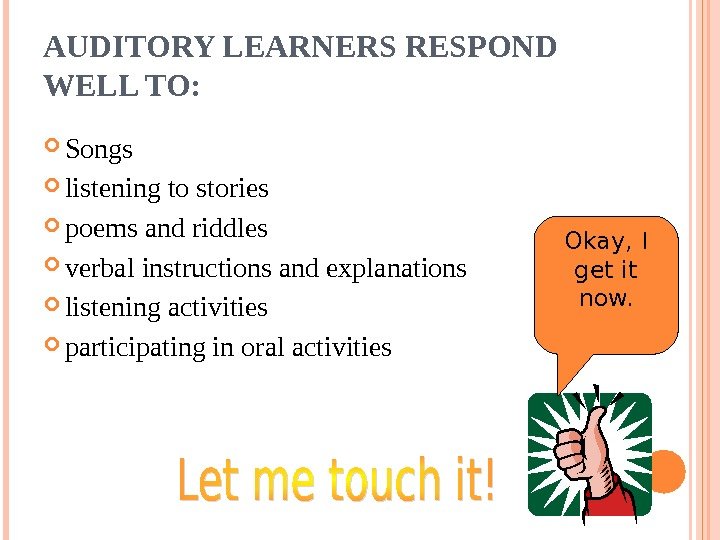
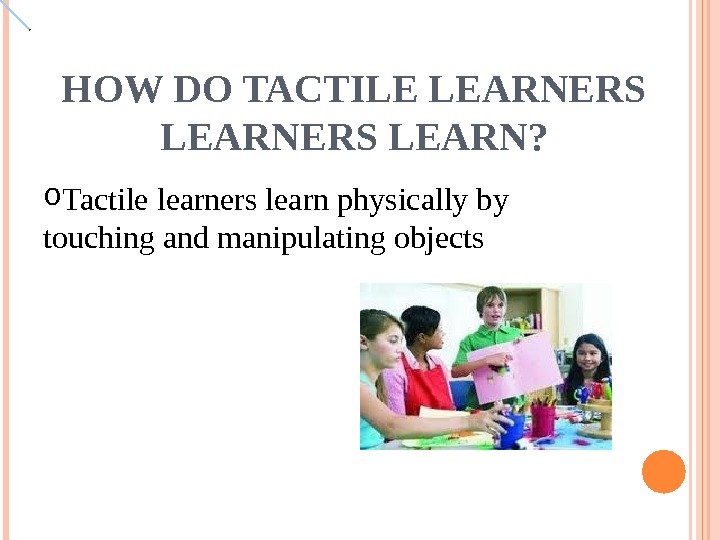
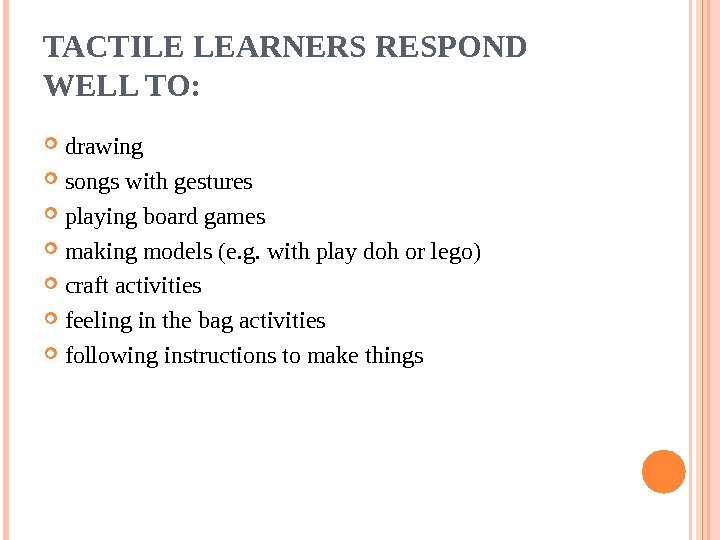
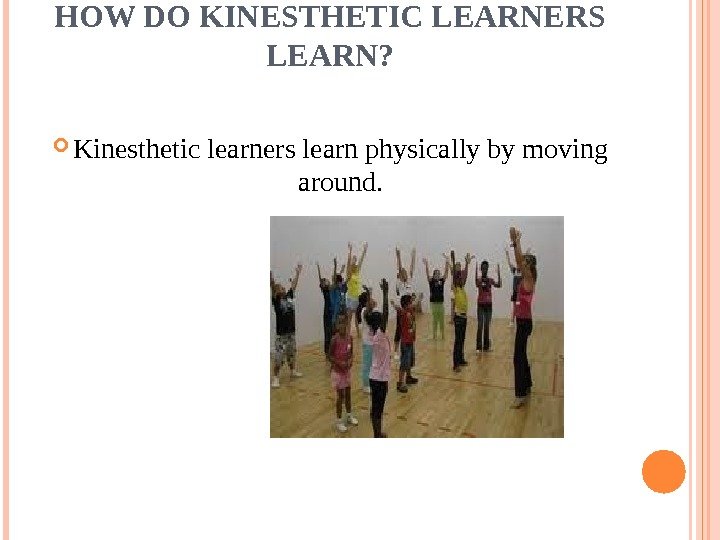
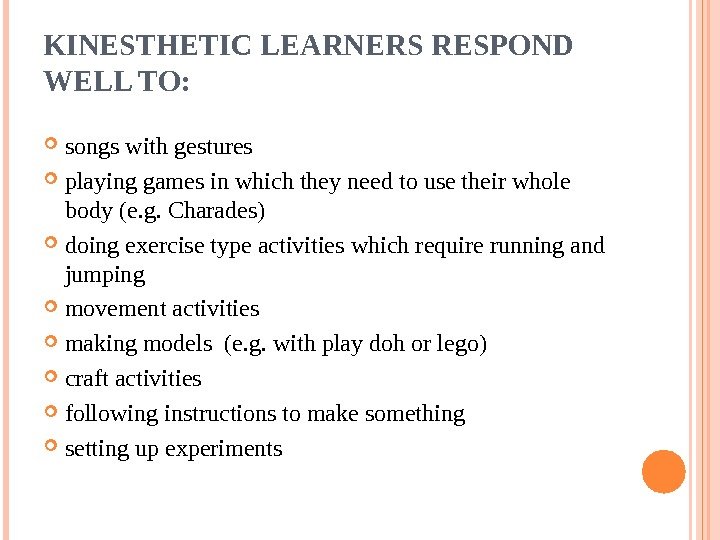
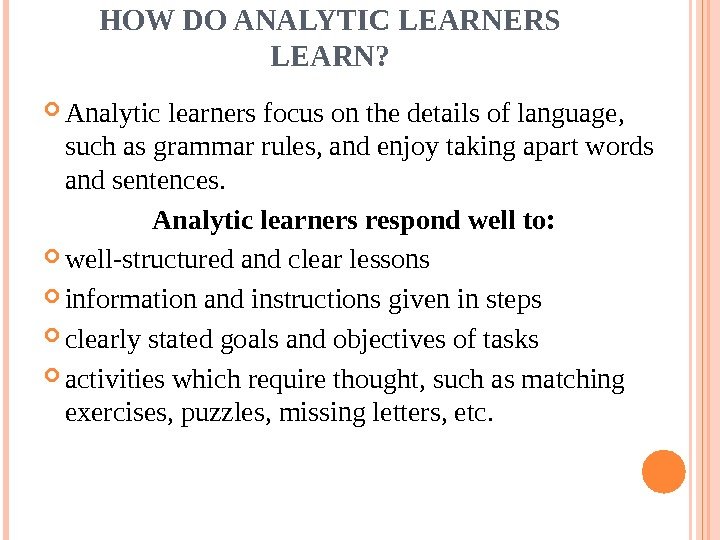
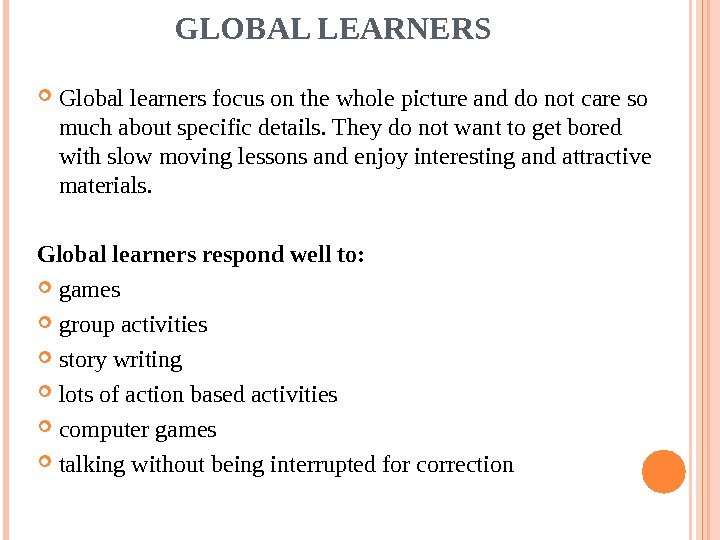
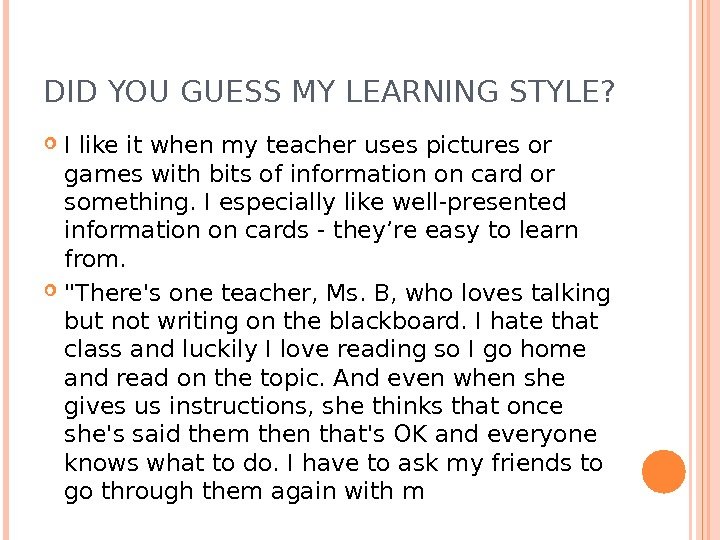
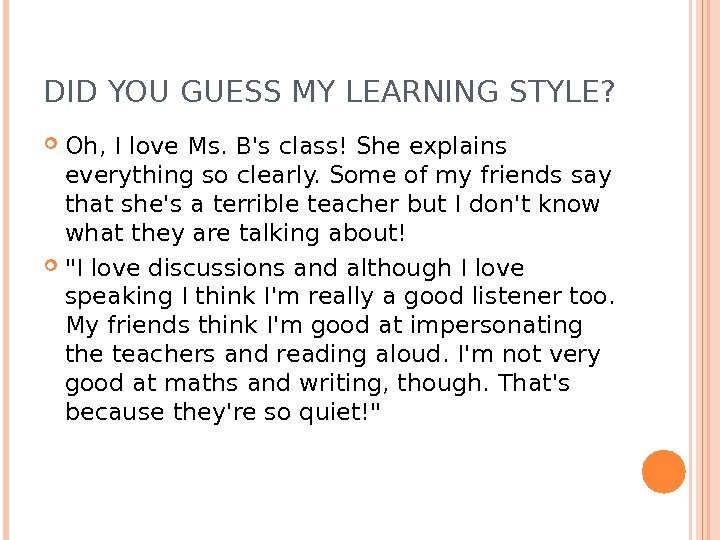
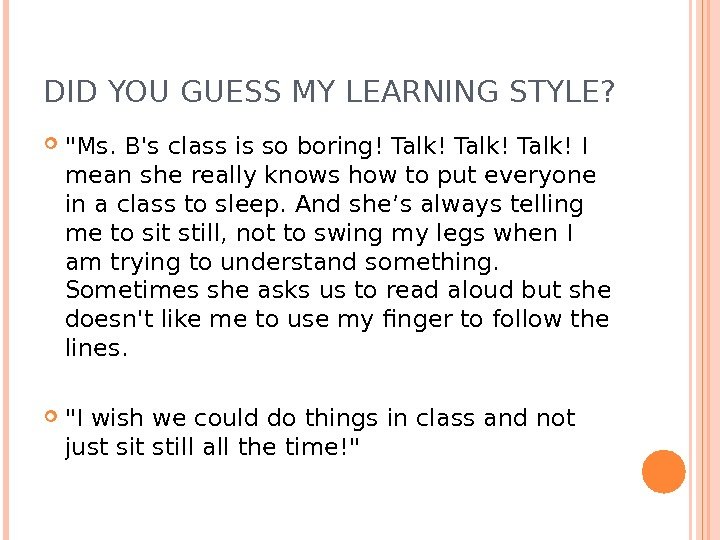
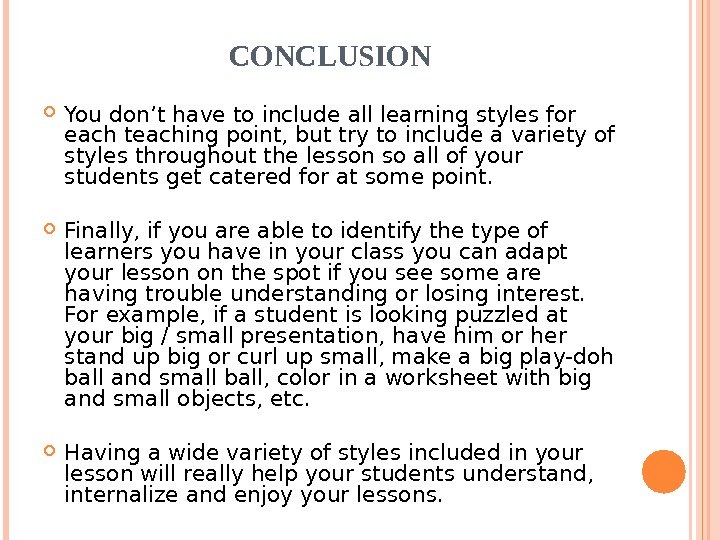

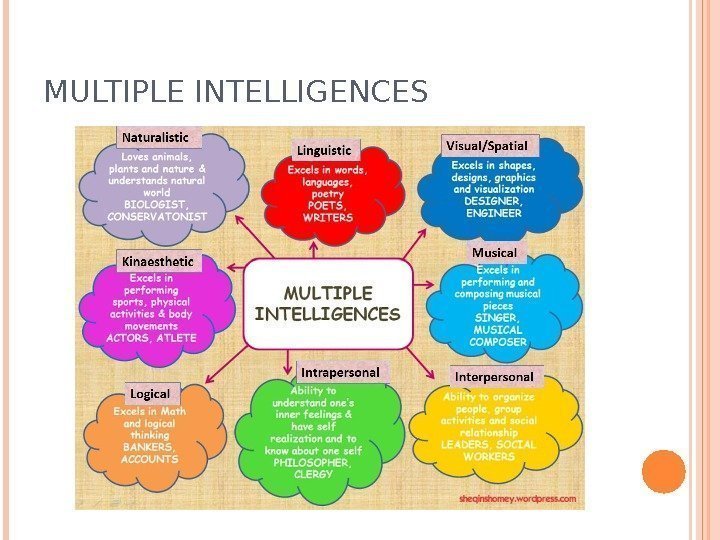
learingstyles.ppt
- Размер: 1.3 Мб
- Автор:
- Количество слайдов: 29
Описание презентации WHAT ARE LEARNING STYLES? Information enters your по слайдам
 WHAT ARE LEARNING STYLES? Information enters your brain three main ways: sight, hearing and touch, which one you use the most is called your Learning Style. Visual Learners Auditory Learners Tactile Learners kinesthetic Learners analytic learners global learners
WHAT ARE LEARNING STYLES? Information enters your brain three main ways: sight, hearing and touch, which one you use the most is called your Learning Style. Visual Learners Auditory Learners Tactile Learners kinesthetic Learners analytic learners global learners
 DIALOGUE Do you feel how hard is it? -Yes, I see
DIALOGUE Do you feel how hard is it? -Yes, I see
 I SEE YOU AVATAR I see you Walking through a dream I see you My light in darkness I pray in my heart That this dream never ends I see me through your eyes Living through life flying high Your love shines the way into paradise You teach me how to see All that’s beautiful
I SEE YOU AVATAR I see you Walking through a dream I see you My light in darkness I pray in my heart That this dream never ends I see me through your eyes Living through life flying high Your love shines the way into paradise You teach me how to see All that’s beautiful
 I SEE YOU AVATAR PART 2 My senses touch your world I never pictured I see me through your eyes Your love shines the way into paradise To the world that you have shown me But my eyes could not division All the colors of love I see me through your eyes Your love shines I see you
I SEE YOU AVATAR PART 2 My senses touch your world I never pictured I see me through your eyes Your love shines the way into paradise To the world that you have shown me But my eyes could not division All the colors of love I see me through your eyes Your love shines I see you
 WHEN YOU SAY NOTHING AT ALL speak right to my heart Without saying a word you can light up the dark Try as may I can never explain What I hear when you don’t say a thing There’s a truth in your eyes saying you’ll never leave me The touch of your hand says you’ll catch me when ever I fall You say it best When you say nothing at all All day long I can hear people talking out loud What’s been said between your heart and mine
WHEN YOU SAY NOTHING AT ALL speak right to my heart Without saying a word you can light up the dark Try as may I can never explain What I hear when you don’t say a thing There’s a truth in your eyes saying you’ll never leave me The touch of your hand says you’ll catch me when ever I fall You say it best When you say nothing at all All day long I can hear people talking out loud What’s been said between your heart and mine
 BLEEDING LOVE» Closed off from love I didn’t need the pain Time starts to pass Before you know it you’re frozen But something happened For the very first time with you My heart melts into the ground Found something true And everyone’s looking round. Thinking I’m going crazy
BLEEDING LOVE» Closed off from love I didn’t need the pain Time starts to pass Before you know it you’re frozen But something happened For the very first time with you My heart melts into the ground Found something true And everyone’s looking round. Thinking I’m going crazy
 «BLEEDING LOVE» They try to pull me away But they don’t know the truth. My heart’s crippled by the vein. That I keep on closing You cut me open and I Keep, keep bleeding love Their piercing sounds fill my ears. Try to fill me with doubt Yet I know that the goal Is to keep me from falling But nothing’s greater than the rush that comes with your embrace And in this world of loneliness Yet everyone around me Thinks that I’m going crazy, maybe
«BLEEDING LOVE» They try to pull me away But they don’t know the truth. My heart’s crippled by the vein. That I keep on closing You cut me open and I Keep, keep bleeding love Their piercing sounds fill my ears. Try to fill me with doubt Yet I know that the goal Is to keep me from falling But nothing’s greater than the rush that comes with your embrace And in this world of loneliness Yet everyone around me Thinks that I’m going crazy, maybe
 CONSIDER ANSWERS TO THESE QUESTIONS 1. Try to remember your first day with a new class. What do you think the learners were thinking about? 2. Apart from thinking, what else do learners do in the classroom? 3. Why do learners do things we do not want them to do in the classroom?
CONSIDER ANSWERS TO THESE QUESTIONS 1. Try to remember your first day with a new class. What do you think the learners were thinking about? 2. Apart from thinking, what else do learners do in the classroom? 3. Why do learners do things we do not want them to do in the classroom?
 GOOD STUDENT FROM A POINT OF VIEW OF WESTERN CULTURE In most Western cultures, education tends to favour the left brain more than the right brain. In other words, Western educational practices place greater emphasis on rational thinking, the ability to express oneself verbally and read well. Is this the same where you work?
GOOD STUDENT FROM A POINT OF VIEW OF WESTERN CULTURE In most Western cultures, education tends to favour the left brain more than the right brain. In other words, Western educational practices place greater emphasis on rational thinking, the ability to express oneself verbally and read well. Is this the same where you work?
 LEFT BRAIN CHARACTERISTICS objective mathematical lists realistic categories language sequential analytical forgetfulness logical verbal rational detail aware
LEFT BRAIN CHARACTERISTICS objective mathematical lists realistic categories language sequential analytical forgetfulness logical verbal rational detail aware
 RIGHT BRAIN CHARACTERISTICS Feelings taste non-verbal visual memory music Unconscious holistic movement creative rhythm Colour dimensions subjective auditory smell touch
RIGHT BRAIN CHARACTERISTICS Feelings taste non-verbal visual memory music Unconscious holistic movement creative rhythm Colour dimensions subjective auditory smell touch
 WHY DO CHILDREN BEHAVE LIKE THAT? • talk • disturb other children in the class • throw paper • answer the teacher’s questions • whisper to each other • read • daydream • write • walk around the class • ask irrelevant questions • draw pictures.
WHY DO CHILDREN BEHAVE LIKE THAT? • talk • disturb other children in the class • throw paper • answer the teacher’s questions • whisper to each other • read • daydream • write • walk around the class • ask irrelevant questions • draw pictures.
 THE WORK OF BRAINS Basically, when the left brain gets tired, it is the right brain that takes over. As a result, young learners start daydreaming, moving about in their chairs and looking out of the window
THE WORK OF BRAINS Basically, when the left brain gets tired, it is the right brain that takes over. As a result, young learners start daydreaming, moving about in their chairs and looking out of the window
 HOW DO VISUAL LEARNERS LEARN? Visual learners learn best by looking. They enjoy reading They often prefer to see the words they are learning and seeing pictures.
HOW DO VISUAL LEARNERS LEARN? Visual learners learn best by looking. They enjoy reading They often prefer to see the words they are learning and seeing pictures.
 VISUAL LEARNERS RESPOND WELL TO: information on the whiteboard flashcards colorful pictures videos story books with pictures computer graphics maps (e. g. treasure maps) charts cartoons posters board games worksheets puzzles
VISUAL LEARNERS RESPOND WELL TO: information on the whiteboard flashcards colorful pictures videos story books with pictures computer graphics maps (e. g. treasure maps) charts cartoons posters board games worksheets puzzles
 HOW DO AUDITORY LEARNERS LEARN? Auditory learners learn best by listening. They work well with spoken instructions They learn quickly by listening to stories and songs. They will not need to see written words to learn.
HOW DO AUDITORY LEARNERS LEARN? Auditory learners learn best by listening. They work well with spoken instructions They learn quickly by listening to stories and songs. They will not need to see written words to learn.
 Okay, I get it now. AUDITORY LEARNERS RESPOND WELL TO: Songs listening to stories poems and riddles verbal instructions and explanations listening activities participating in oral activities
Okay, I get it now. AUDITORY LEARNERS RESPOND WELL TO: Songs listening to stories poems and riddles verbal instructions and explanations listening activities participating in oral activities
 HOW DO TACTILE LEARNERS LEARN? o Tactile learners learn physically by touching and manipulating objects
HOW DO TACTILE LEARNERS LEARN? o Tactile learners learn physically by touching and manipulating objects
 TACTILE LEARNERS RESPOND WELL TO: drawing songs with gestures playing board games making models (e. g. with play doh or lego) craft activities feeling in the bag activities following instructions to make things
TACTILE LEARNERS RESPOND WELL TO: drawing songs with gestures playing board games making models (e. g. with play doh or lego) craft activities feeling in the bag activities following instructions to make things
 HOW DO KINESTHETIC LEARNERS LEARN? Kinesthetic learners learn physically by moving around.
HOW DO KINESTHETIC LEARNERS LEARN? Kinesthetic learners learn physically by moving around.
 KINESTHETIC LEARNERS RESPOND WELL TO: songs with gestures playing games in which they need to use their whole body (e. g. Charades) doing exercise type activities which require running and jumping movement activities making models (e. g. with play doh or lego) craft activities following instructions to make something setting up experiments
KINESTHETIC LEARNERS RESPOND WELL TO: songs with gestures playing games in which they need to use their whole body (e. g. Charades) doing exercise type activities which require running and jumping movement activities making models (e. g. with play doh or lego) craft activities following instructions to make something setting up experiments
 HOW DO ANALYTIC LEARNERS LEARN? Analytic learners focus on the details of language, such as grammar rules, and enjoy taking apart words and sentences. Analytic learners respond well to: well-structured and clear lessons information and instructions given in steps clearly stated goals and objectives of tasks activities which require thought, such as matching exercises, puzzles, missing letters, etc.
HOW DO ANALYTIC LEARNERS LEARN? Analytic learners focus on the details of language, such as grammar rules, and enjoy taking apart words and sentences. Analytic learners respond well to: well-structured and clear lessons information and instructions given in steps clearly stated goals and objectives of tasks activities which require thought, such as matching exercises, puzzles, missing letters, etc.
 GLOBAL LEARNERS Global learners focus on the whole picture and do not care so much about specific details. They do not want to get bored with slow moving lessons and enjoy interesting and attractive materials. Global learners respond well to: games group activities story writing lots of action based activities computer games talking without being interrupted for correction
GLOBAL LEARNERS Global learners focus on the whole picture and do not care so much about specific details. They do not want to get bored with slow moving lessons and enjoy interesting and attractive materials. Global learners respond well to: games group activities story writing lots of action based activities computer games talking without being interrupted for correction
 DID YOU GUESS MY LEARNING STYLE? I like it when my teacher uses pictures or games with bits of information on card or something. I especially like well-presented information on cards — they’re easy to learn from. «There’s one teacher, Ms. B, who loves talking but not writing on the blackboard. I hate that class and luckily I love reading so I go home and read on the topic. And even when she gives us instructions, she thinks that once she’s said them then that’s OK and everyone knows what to do. I have to ask my friends to go through them again with m
DID YOU GUESS MY LEARNING STYLE? I like it when my teacher uses pictures or games with bits of information on card or something. I especially like well-presented information on cards — they’re easy to learn from. «There’s one teacher, Ms. B, who loves talking but not writing on the blackboard. I hate that class and luckily I love reading so I go home and read on the topic. And even when she gives us instructions, she thinks that once she’s said them then that’s OK and everyone knows what to do. I have to ask my friends to go through them again with m
 DID YOU GUESS MY LEARNING STYLE? Oh, I love Ms. B’s class! She explains everything so clearly. Some of my friends say that she’s a terrible teacher but I don’t know what they are talking about! «I love discussions and although I love speaking I think I’m really a good listener too. My friends think I’m good at impersonating the teachers and reading aloud. I’m not very good at maths and writing, though. That’s because they’re so quiet!»
DID YOU GUESS MY LEARNING STYLE? Oh, I love Ms. B’s class! She explains everything so clearly. Some of my friends say that she’s a terrible teacher but I don’t know what they are talking about! «I love discussions and although I love speaking I think I’m really a good listener too. My friends think I’m good at impersonating the teachers and reading aloud. I’m not very good at maths and writing, though. That’s because they’re so quiet!»
 DID YOU GUESS MY LEARNING STYLE? «Ms. B’s class is so boring! Talk! I mean she really knows how to put everyone in a class to sleep. And she’s always telling me to sit still, not to swing my legs when I am trying to understand something. Sometimes she asks us to read aloud but she doesn’t like me to use my finger to follow the lines. «I wish we could do things in class and not just sit still all the time!»
DID YOU GUESS MY LEARNING STYLE? «Ms. B’s class is so boring! Talk! I mean she really knows how to put everyone in a class to sleep. And she’s always telling me to sit still, not to swing my legs when I am trying to understand something. Sometimes she asks us to read aloud but she doesn’t like me to use my finger to follow the lines. «I wish we could do things in class and not just sit still all the time!»
 CONCLUSION You don’t have to include all learning styles for each teaching point, but try to include a variety of styles throughout the lesson so all of your students get catered for at some point. Finally, if you are able to identify the type of learners you have in your class you can adapt your lesson on the spot if you see some are having trouble understanding or losing interest. For example, if a student is looking puzzled at your big / small presentation, have him or her stand up big or curl up small, make a big play-doh ball and small ball, color in a worksheet with big and small objects, etc. Having a wide variety of styles included in your lesson will really help your students understand, internalize and enjoy your lessons.
CONCLUSION You don’t have to include all learning styles for each teaching point, but try to include a variety of styles throughout the lesson so all of your students get catered for at some point. Finally, if you are able to identify the type of learners you have in your class you can adapt your lesson on the spot if you see some are having trouble understanding or losing interest. For example, if a student is looking puzzled at your big / small presentation, have him or her stand up big or curl up small, make a big play-doh ball and small ball, color in a worksheet with big and small objects, etc. Having a wide variety of styles included in your lesson will really help your students understand, internalize and enjoy your lessons.
 HOME TASK:
HOME TASK:
 MULTIPLE INTELLIGENCES
MULTIPLE INTELLIGENCES
